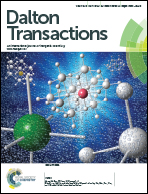Heterodinuclear (Sm, Tb) lanthanide pivalates with heterocyclic N-donors: synthesis, structure, thermal behavior, and magnetic and photoluminescence properties†
Abstract
Heterobimetallic complexes [SmTb(piv)6(phen)2] (1), [SmTb(piv)6(bath)2]·1.75EtOH (2a·1.75EtOH), [SmTb(piv)6(bath)2]·2EtOH (2b·2EtOH), and [SmTb(piv)6(bath)2]·EtOH (2b·EtOH), where piv is (CH3)3CCO2−, phen is 1,10-phenanthroline, and bath is 4,7-diphenyl-1,10-phenanthroline, were synthesized and studied by X-ray diffraction. It was shown that complexes 2a·1.75EtOH and 2b·2EtOH have different molecular and crystal structures. Complexes 2a·1.75EtOH, 2b·2EtOH, and 2b·EtOH differ in the structural functions of μ2-piv anions. 2a·1.75EtOH contains two μ2-piv-κ2O,O′ anions and two μ2-piv-κ2O,O,O′ anions, whereas 2b·2EtOH and 2b·EtOH have four μ2-piv-κ2O,O′ anions. According to the mass spectrometry data, the dimeric molecule [SmTb(piv)6] is the major metal-containing component of gas-phase complexes 1, 2a·1.75EtOH, and 2b·2EtOH. The characteristic features of the thermal behavior of these complexes were revealed, and their magnetic and photoluminescence (PL) properties were investigated. A unique feature of desolvated complexes 2a·1.75EtOH and 2b·2EtOH is melting at high temperatures before thermal decomposition. The magnetic properties of 1 and 2a·1.75EtOH are determined mainly by the Tb3+ ions. The optical properties of these complexes and their homodinuclear analogs were analyzed by photoluminescence, excitation, phosphorescence, and scattering spectroscopy and by lifetime measurements at 77 K and 300 K. As the temperature decreases to 77 K, the PL intensity of Tb3+ ions in 1 and 2a·1.75EtOH substantially increases by 40 and 100 times, respectively, compared to 300 K. The PL color evidently changes from red at 300 K to bright green at 77 K. Based on these results, the mechanism of intramolecular energy transfer between the ligand levels and Sm3+ and Tb3+ ions under UV radiation was proposed.


 Please wait while we load your content...
Please wait while we load your content...